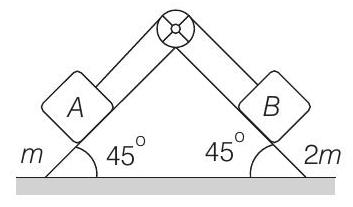Laws of Motion 3 Question 20
21. Block
(1997C, 5M)

(a) the acceleration of
(b) tension in the string and
(c) the magnitude and direction of the force of friction acting on
Show Answer
Answer:
Correct Answer: 21. (a) acceleration
Solution:
- (a) Acceleration of block
Maximum friction force that can be obtained at

Similarly,
Therefore, maximum value of friction that can be obtained on the system is
Net pulling force on the system is
From Eqs. (i) and (ii), we can see that
Net pulling force
(b) and (c) Tension in the string and friction at
Net pulling force on the system (block
Therefore, total friction force on the blocks should also be equal to
or
Now, since the blocks will start moving from block
Here,
Therefore,
Hence,
and
The FBD of the whole system will be as shown in the figure.

Therefore, friction on
Now, for tension
Equilibrium of
Similarly, equilibrium of
Therefore, tension in the string is






